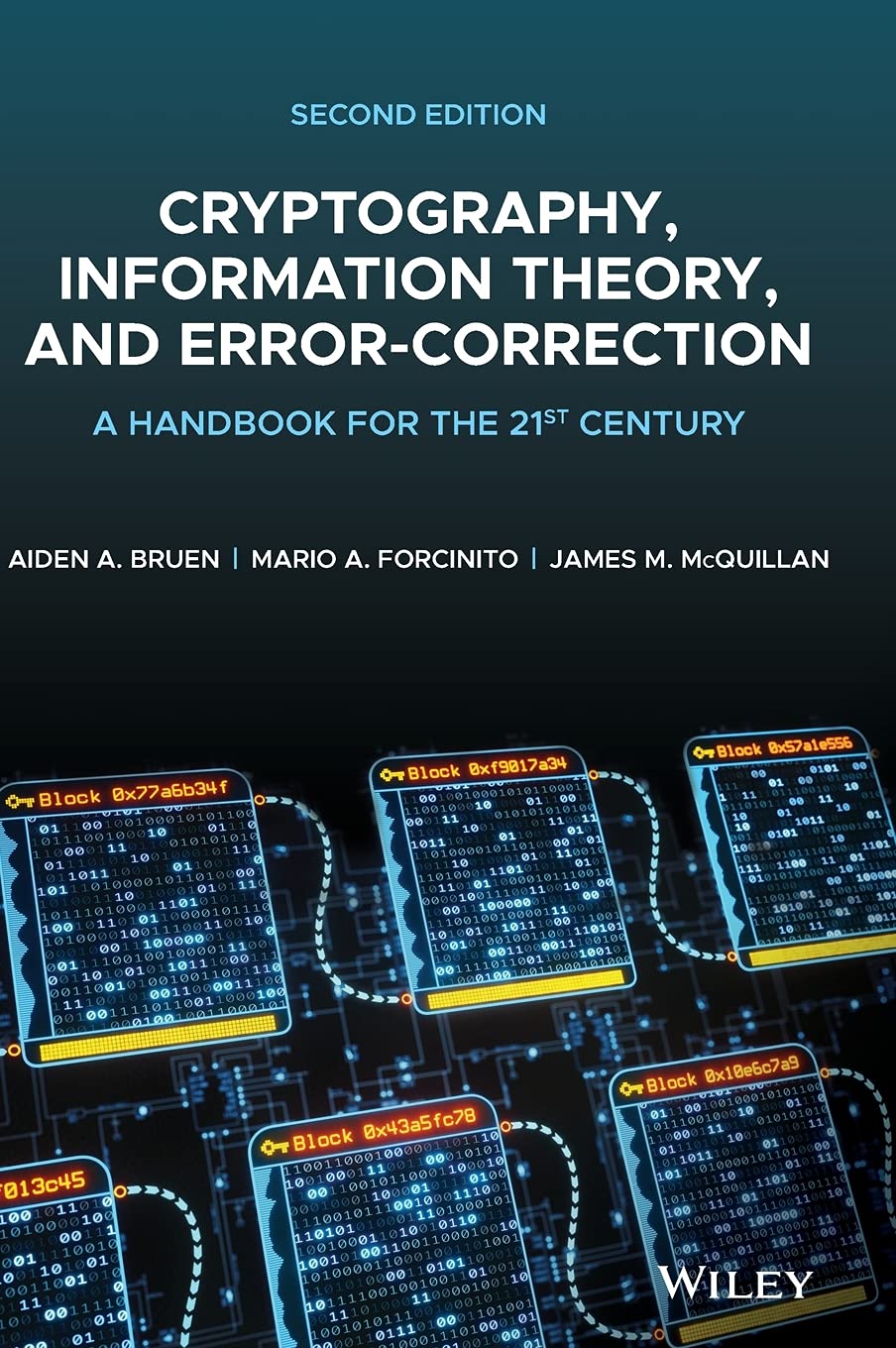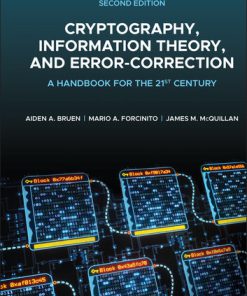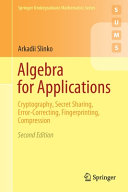Cryptography Information Theory and Error Correction 2nd Edition by Aiden A Bruen, Mario A Forcinito, James M Mcquillan ISBN 1119582423 9781119582397
$50.00 Original price was: $50.00.$25.00Current price is: $25.00.
Cryptography Information Theory and Error Correction 2nd Edition by Aiden A Bruen, Mario A Forcinito, James M Mcquillan – Ebook PDF Instant Download/Delivery: 1119582423 ,9781119582397
Full download Cryptography Information Theory and Error Correction 2nd Edition after payment

Product details:
ISBN 10: 1119582423
ISBN 13: 9781119582397
Author: Aiden A Bruen, Mario A Forcinito, James M Mcquillan
CRYPTOGRAPHY, INFORMATION THEORY, AND ERROR-CORRECTION
A rich examination of the technologies supporting secure digital information transfers from respected leaders in the field
As technology continues to evolve Cryptography, Information Theory, and Error-Correction: A Handbook for the 21ST Century is an indispensable resource for anyone interested in the secure exchange of financial information. Identity theft, cybercrime, and other security issues have taken center stage as information becomes easier to access. Three disciplines offer solutions to these digital challenges: cryptography, information theory, and error-correction, all of which are addressed in this book.
This book is geared toward a broad audience. It is an excellent reference for both graduate and undergraduate students of mathematics, computer science, cybersecurity, and engineering. It is also an authoritative overview for professionals working at financial institutions, law firms, and governments who need up-to-date information to make critical decisions. The book’s discussions will be of interest to those involved in blockchains as well as those working in companies developing and applying security for new products, like self-driving cars. With its reader-friendly style and interdisciplinary emphasis this book serves as both an ideal teaching text and a tool for self-learning for IT professionals, statisticians, mathematicians, computer scientists, electrical engineers, and entrepreneurs.
Six new chapters cover current topics like Internet of Things security, new identities in information theory, blockchains, cryptocurrency, compression, cloud computing and storage. Increased security and applicable research in elliptic curve cryptography are also featured. The book also:
- Shares vital, new research in the field of information theory
- Provides quantum cryptography updates
- Includes over 350 worked examples and problems for greater understanding of ideas.
Cryptography, Information Theory, and Error-Correction guides readers in their understanding of reliable tools that can be used to store or transmit digital information safely.
Cryptography Information Theory and Error Correction 2nd Edition Table of contents:
Part I: Mainly Cryptography
Chapter 1: Historical Introduction and the Life and Work of Claude E. Shannon
1.1 Historical Background
1.2 Brief Biography of Claude E. Shannon
1.3 Career
1.4 Personal – Professional
1.5 Scientific Legacy
1.6 The Data Encryption Standard Code, DES, 1977–2005
1.7 Post‐Shannon Developments
Notes
Chapter 2: Classical Ciphers and Their Cryptanalysis
2.1 Introduction
2.2 The Caesar Cipher
2.3 The Scytale Cipher
2.4 The Vigenère Cipher
2.5 Frequency Analysis
2.6 Breaking the Vigenère Cipher, Babbage–Kasiski
2.7 The Enigma Machine and Its Mathematics
2.8 Modern Enciphering Systems
2.9 Problems
2.10 Solutions
Chapter 3: RSA, Key Searches, TLS, and Encrypting Email
3.1 The Basic Idea of Cryptography
3.2 Public Key Cryptography and RSA on a Calculator
3.3 The General RSA Algorithm
3.4 Public Key Versus Symmetric Key
3.5 Attacks, Security, Catch‐22 of Cryptography
3.6 Summary of Encryption
3.7 The Diffie–Hellman Key Exchange
3.8 Intruder‐in‐the‐Middle Attack on the Diffie–Hellman (or Elliptic Curve) Key‐Exchange
3.9 TLS (Transport Layer Security)
3.10 PGP and GPG
3.11 Problems
3.12 Solutions
Notes
Chapter 4: The Fundamentals of Modern Cryptography
4.1 Encryption Revisited
4.2 Block Ciphers, Shannon’s Confusion and Diffusion
4.3 Perfect Secrecy, Stream Ciphers, One‐Time Pad
4.4 Hash Functions
4.5 Message Integrity Using Symmetric Cryptography
4.6 General Public Key Cryptosystems
4.7 Digital Signatures
4.8 Modifying Encrypted Data and Homomorphic Encryption
4.9 Quantum Encryption Using Polarized Photons
4.10 Quantum Encryption Using Entanglement
4.11 Quantum Key Distribution is Not a Silver Bullet
4.12 Postquantum Cryptography
4.13 Key Management and Kerberos
4.14 Problems
4.15 Solutions
Chapter 5: Modes of Operation for AES and Symmetric Algorithms
5.1 Modes of Operation
5.2 The Advanced Encryption Standard Code
5.3 Overview of AES
Chapter 6: Elliptic Curve Cryptography (ECC)
6.1 Abelian Integrals, Fields, Groups
6.2 Curves, Cryptography
6.3 The Hasse Theorem, and an Example
6.4 More Examples
6.5 The Group Law on Elliptic Curves
6.6 Key Exchange with Elliptic Curves
6.7 Elliptic Curves mod n
6.8 Encoding Plain Text
6.9 Security of ECC
6.10 More Geometry of Cubic Curves
6.11 Cubic Curves and Arcs
6.12 Homogeneous Coordinates
6.13 Fermat’s Last Theorem, Elliptic Curves, Gerhard Frey
6.14 A Modification of the Standard Version of Elliptic Curve Cryptography
6.15 Problems
6.16 Solutions
Chapter 7: General and Mathematical Attacks in Cryptography
7.1 Cryptanalysis
7.2 Soft Attacks
7.3 Brute‐Force Attacks
7.4 Man‐in‐the‐Middle Attacks
7.5 Relay Attacks, Car Key Fobs
7.6 Known Plain Text Attacks
7.7 Known Cipher Text Attacks
7.8 Chosen Plain Text Attacks
7.9 Chosen Cipher Text Attacks, Digital Signatures
7.10 Replay Attacks
7.11 Birthday Attacks
7.12 Birthday Attack on Digital Signatures
7.13 Birthday Attack on the Discrete Log Problem
7.14 Attacks on RSA
7.15 Attacks on RSA using Low‐Exponents
7.16 Timing Attack
7.17 Differential Cryptanalysis
7.18 Attacks Utilizing Preprocessing
7.19 Cold Boot Attacks on Encryption Keys
7.20 Implementation Errors and Unforeseen States
7.21 Tracking. Bluetooth, WiFi, and Your Smart Phone
7.22 Keep Up with the Latest Attacks (If You Can)
Notes
Chapter 8: Practical Issues in Modern Cryptography and Communications
8.1 Introduction
8.2 Hot Issues
8.3 Authentication
8.4 User Anonymity
8.5 E‐commerce
8.6 E‐government
8.7 Key Lengths
8.8 Digital Rights
8.9 Wireless Networks
8.10 Communication Protocols
Notes
Part II: Mainly Information Theory
Chapter 9: Information Theory and its Applications
9.1 Axioms, Physics, Computation
9.2 Entropy
9.3 Information Gained, Cryptography
9.4 Practical Applications of Information Theory
9.5 Information Theory and Physics
9.6 Axiomatics of Information Theory
9.7 Number Bases, Erdös and the Hand of God
9.8 Weighing Problems and Your MBA
9.9 Shannon Bits, the Big Picture
Chapter 10: Random Variables and Entropy
10.1 Random Variables
10.2 Mathematics of Entropy
10.3 Calculating Entropy
10.4 Conditional Probability
10.5 Bernoulli Trials
10.6 Typical Sequences
10.7 Law of Large Numbers
10.8 Joint and Conditional Entropy
10.9 Applications of Entropy
10.10 Calculation of Mutual Information
10.11 Mutual Information and Channels
10.12 The Entropy of X + Y
10.13 Subadditivity of the Function –x log x
10.14 Entropy and Cryptography
10.15 Problems
10.16 Solutions
Chapter 11: Source Coding, Redundancy
11.1 Introduction, Source Extensions
11.2 Encodings, Kraft, McMillan
11.3 Block Coding, the Oracle, Yes–No Questions
11.4 Optimal Codes
11.5 Huffman Coding
11.6 Optimality of Huffman Coding
11.7 Data Compression, Redundancy
11.8 Problems
11.9 Solutions
Chapter 12: Channels, Capacity, the Fundamental Theorem
12.1 Abstract Channels
12.2 More Specific Channels
12.3 New Channels from Old, Cascades
12.4 Input Probability, Channel Capacity
12.5 Capacity for General Binary Channels, Entropy
12.6 Hamming Distance
12.7 Improving Reliability of a Binary Symmetric Channel
12.8 Error Correction, Error Reduction, Good Redundancy
12.9 The Fundamental Theorem of Information Theory
12.10 Proving the Fundamental Theorem
12.11 Summary, the Big Picture
12.12 Postscript: The Capacity of the Binary Symmetric Channel
12.13 Problems
12.14 Solutions
Chapter 13: Signals, Sampling, Coding Gain, Shannon’s Information Capacity Theorem
13.1 Continuous Signals, Shannon’s Sampling Theorem
13.2 The Band‐Limited Capacity Theorem
13.3 The Coding Gain
Chapter 14: Ergodic and Markov Sources, Language Entropy
14.1 General and Stationary Sources
14.2 Ergodic Sources
14.3 Markov Chains and Markov Sources
14.4 Irreducible Markov Sources, Adjoint Source
14.5 Cascades and the Data Processing Theorem
14.6 The Redundancy of Languages
14.7 Problems
14.8 Solutions
Chapter 15: Perfect Secrecy: The New Paradigm
15.1 Symmetric Key Cryptosystems
15.2 Perfect Secrecy and Equiprobable Keys
15.3 Perfect Secrecy and Latin Squares
15.4 The Abstract Approach to Perfect Secrecy
15.5 Cryptography, Information Theory, Shannon
15.6 Unique Message from Ciphertext, Unicity
15.7 Problems
15.8 Solutions
Chapter 16: Shift Registers (LFSR) and Stream Ciphers
16.1 Vernam Cipher, Psuedo‐Random Key
16.2 Construction of Feedback Shift Registers
16.3 Periodicity
16.4 Maximal Periods, Pseudo‐Random Sequences
16.5 Determining the Output from 2m Bits
16.6 The Tap Polynomial and the Period
16.7 Short Linear Feedback Shift Registers and the Berlekamp‐Massey Algorithm
16.8 Problems
16.9 Solutions
Chapter 17: Compression and Applications
17.1 Introduction, Applications
17.2 The Memory Hierarchy of a Computer
17.3 Memory Compression
17.4 Lempel–Ziv Coding
17.5 The WKdm Algorithms
17.6 Main Memory – to Compress or Not to Compress
17.7 Problems
17.8 Solutions
Part III: Mainly Error‐Correction
Chapter 18: Error‐Correction, Hadamard, and Bruen–Ott
18.1 General Ideas of Error Correction
18.2 Error Detection, Error Correction
18.3 A Formula for Correction and Detection
18.4 Hadamard Matrices
18.5 Mariner, Hadamard, and Reed–Muller
18.6 Reed–Muller Codes
18.7 Block Designs
18.8 The Rank of Incidence Matrices
18.9 The Main Coding Theory Problem, Bounds
18.10 Update on the Reed–Muller Codes: The Proof of an Old Conjecture
18.11 Problems
18.12 Solutions
Chapter 19: Finite Fields, Modular Arithmetic, Linear Algebra, and Number Theory
19.1 Modular Arithmetic
19.2 A Little Linear Algebra
19.3 Applications to RSA
19.4 Primitive Roots for Primes and Diffie–Hellman
19.5 The Extended Euclidean Algorithm
19.6 Proof that the RSA Algorithm Works
19.7 Constructing Finite Fields
19.8 Pollard’s p-1 Factoring Algorithm
19.9 Latin Squares
19.10 Computational Complexity, Turing Machines, Quantum Computing
19.11 Problems
19.12 Solutions
Note
Chapter 20: Introduction to Linear Codes
20.1 Repetition Codes and Parity Checks
20.2 Details of Linear Codes
20.3 Parity Checks, the Syndrome, and Weights
20.4 Hamming Codes, an Inequality
20.5 Perfect Codes, Errors, and the BSC
20.6 Generalizations of Binary Hamming Codes
20.7 The Football Pools Problem, Extended Hamming Codes
20.8 Golay Codes
20.9 McEliece Cryptosystem
20.10 Historical Remarks
20.11 Problems
20.12 Solutions
Chapter 21: Cyclic Linear Codes, Shift Registers, and CRC
21.1 Cyclic Linear Codes
21.2 Generators for Cyclic Codes
21.3 The Dual Code
21.4 Linear Feedback Shift Registers and Codes
21.5 Finding the Period of a LFSR
21.6 Cyclic Redundancy Check (CRC)
21.7 Problems
21.8 Solutions
Chapter 22: Reed‐Solomon and MDS Codes, and the Main Linear Coding Theory Problem (LCTP)
22.1 Cyclic Linear Codes and Vandermonde
22.2 The Singleton Bound for Linear Codes
22.3 Reed–Solomon Codes
22.4 Reed‐Solomon Codes and the Fourier Transform Approach
22.5 Correcting Burst Errors, Interleaving
22.6 Decoding Reed‐Solomon Codes, Ramanujan, and Berlekamp–Massey
22.7 An Algorithm for Decoding and an Example
22.8 Long MDS Codes and a Partial Solution of a 60 Year‐Old Problem
22.9 Problems
22.10 Solutions
Chapter 23: MDS Codes, Secret Sharing, and Invariant Theory
23.1 Some Facts Concerning MDS Codes
23.2 The Case k = 2, Bruck Nets
23.3 Upper Bounds on MDS Codes, Bruck–Ryser
23.4 MDS Codes and Secret Sharing Schemes
23.5 MacWilliams Identities, Invariant Theory
23.6 Codes, Planes, and Blocking Sets
23.7 Long Binary Linear Codes of Minimum Weight at Least 4
23.8 An Inverse Problem and a Basic Question in Linear Algebra
Chapter 24: Key Reconciliation, Linear Codes, and New Algorithms
24.1 Symmetric and Public Key Cryptography
24.2 General Background
24.3 The Secret Key and the Reconciliation Algorithm
24.4 Equality of Remnant Keys: The Halting Criterion
24.5 Linear Codes: The Checking Hash Function
24.6 Convergence and Length of Keys
24.7 Main Results
24.8 Some Details on the Random Permutation
24.9 The Case Where Eve Has Nonzero Initial Information
24.10 Hash Functions Using Block Designs
24.11 Concluding Remarks
Note
Chapter 25: New Identities for the Shannon Function with Applications
25.1 Extensions of a Binary Symmetric Channel
25.2 A Basic Entropy Equality
25.3 The New Identities
25.4 Applications to Cryptography and a Shannon‐Type Limit
25.5 Problems
25.6 Solutions
Chapter 26: Blockchain and Bitcoin
26.1 Ledgers, Blockchains
26.2 Hash Functions, Cryptographic Hashes
26.3 Digital Signatures
26.4 Bitcoin and Cryptocurrencies
26.5 The Append‐Only Network, Identities, Timestamp, Definition of a Bitcoin
26.6 The Bitcoin Blockchain and Merkle Roots
26.7 Mining, Proof‐of‐Work, Consensus
26.8 Thwarting Double Spending
Chapter 27: IoT, The Internet of Things
27.1 Introduction
27.2 Analog to Digital (A/D) Converters
27.3 Programmable Logic Controller
27.4 Embedded Operating Systems
27.5 Evolution, From SCADA to the Internet of Things
27.6 Everything is Fun and Games until Somebody Releases a Stuxnet
27.7 Securing the IoT, a Mammoth Task
27.8 Privacy and Security
Notes
Chapter 28: In the Cloud
28.1 Introduction
28.2 Distributed Systems
28.3 Cloud Storage – Availability and Copyset Replication
28.4 Homomorphic Encryption
28.5 Cybersecurity
28.6 Problems
28.7 Solutions
Chapter 29: Review Problems and Solutions
29.1 Problems
29.2 Solutions
Appendix A
A.1 ASCII
Appendix B
B.1 Shannon’s Entropy Table
Glossary
References
Index
People also search for Cryptography Information Theory and Error Correction 2nd Edition:
information system security and cryptography past papers
quantum information and cryptography
cryptography and information security viva questions
quantum information computation and cryptography
qr code collect information
Tags: Aiden A Bruen, Mario A Forcinito, James M Mcquillan, Cryptography Information, Error Correction
You may also like…
Computers - Security
Computers - Networking
The Information A History a Theory a Flood 1st Edition by Gleick James ISBN 978-0007432523
Relationships & Lifestyle - Relationships
Education Studies & Teaching - Educational Theory
Inclusive Education for the 21st Century: Theory, Policy and Practice 2nd Edition Linda J. Graham
Relationships & Lifestyle - Personal Growth & Inspiration
Education Studies & Teaching - Teaching & Teacher Training
Reference - Library & Information Science
Politics & Philosophy - Sociology
Mathematics - Algebra











